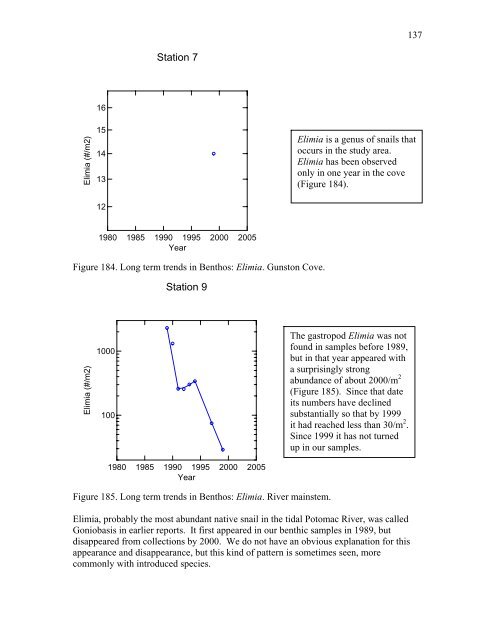NEW: Annual Report - George Mason University
NEW: Annual Report - George Mason University
NEW: Annual Report - George Mason University
You also want an ePaper? Increase the reach of your titles
YUMPU automatically turns print PDFs into web optimized ePapers that Google loves.
Elimia (#/m2)<br />
16<br />
15<br />
14<br />
13<br />
12<br />
Station 7<br />
1980 1985 1990 1995 2000 2005<br />
Year<br />
Figure 184. Long term trends in Benthos: Elimia. Gunston Cove.<br />
Elimia (#/m2)<br />
1000<br />
100<br />
Station 9<br />
1980 1985 1990 1995 2000 2005<br />
Year<br />
Figure 185. Long term trends in Benthos: Elimia. River mainstem.<br />
137<br />
Elimia is a genus of snails that<br />
occurs in the study area.<br />
Elimia has been observed<br />
only in one year in the cove<br />
(Figure 184).<br />
The gastropod Elimia was not<br />
found in samples before 1989,<br />
but in that year appeared with<br />
a surprisingly strong<br />
abundance of about 2000/m 2<br />
(Figure 185). Since that date<br />
its numbers have declined<br />
substantially so that by 1999<br />
it had reached less than 30/m 2 .<br />
Since 1999 it has not turned<br />
up in our samples.<br />
Elimia, probably the most abundant native snail in the tidal Potomac River, was called<br />
Goniobasis in earlier reports. It first appeared in our benthic samples in 1989, but<br />
disappeared from collections by 2000. We do not have an obvious explanation for this<br />
appearance and disappearance, but this kind of pattern is sometimes seen, more<br />
commonly with introduced species.
















